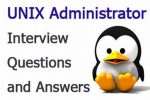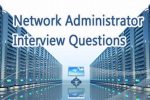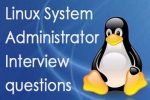Unix Administrator Interview Questions and Answers
When you are preparing yourself for the interview of UNIX administrator, you need to focus on the core ideas of UNIX that involves some commands. Making yourself perfect for an interview is always a tough thing as you don’t know what you are going to face in the interview hall. It is always better to get an idea about the possible questions that you might be asked to keep yourself ahead in the competition. Those who are applying for the UNIX administrator should have the sound knowledge in the technical concept. Here a set of questions is given to help you out of your doubts.
1 Q: what is the definition of UNIX?
A: UNIX is an operating system (OS) which is designed for both Multitasking and Multi-user functions. This portable OS can efficiently perform on different hardware platforms, which brings a great advantage for the user. The programs are written In C and it allows a user to process the data.
2 Q: Explain the BIOS.
A: BIOS is the acronym of Basic Input and Output system, which mainly performs the task at the time of booting that includes searching, loading and executing of the boot programs. It is also searching for the boot loader such as CD-ROM, floppy and hard drive. One can also change the boot sequence while it starts up by pressing the F1 or F key depends on your computer.
3 Q: What are filters?
A: The term of filter is used to refer program that takes input from the standard input point and then perform some tasks on that input to bring the exact result to the standard output. This program can be used in two other programs.
4 Q: Explain the Kernel.
A: Kernel works as the master program in the UNIX operating system that controls the computer resources by allocating them to different users and to the different tasks. It interacts with the user through a shell while logging. The shell is the interface between the user and the system, which works as a command interpreter.
5 Q: Explain the differences between cmp and diff commands.
A: cmp command is used to compare the two files by byte to byte and also presents what changes one needs to do to make the file unique from each other. It helps to check the differences in the files. Whereas, diff command is used to denote the differences in the text format and it lists down all the differences between the two files.
6 Q: Explain the multi-user and multi-tasking process.
A: Multi-user means a machine can be used by more than one person at the same without having any problem to access the data and the multitasking means a machine can be used for performing the multiple task at the same time. UNIX is made based on the multi-tasking and multi-user process.
7 Q: What is incode in the Unix system?
A: an incode is the data structure, which is used for the file system. It contains the details regarding a file that includes the location of the file on a disk, its size, the date of using the file, information about the changes, the owner of the file and other details. Generally, it carries the information of a file.
8 Q: Explain the NFS and its task.
A: The Network File System (NFS) enables one to access the data of remote computer within a network. The file system can appear as another local disk in the computer. A command is used for exporting NFS directories. The soft and hard mount is used for sending the file when it is mounted with soft option that means if the server does not respond, it returns an error whereas the hard mounts uses the retry manner to send the file.
9 Q: What are the responsibilities a shell looks after?
A: A shell looks after lots of responsibilities such as program execution, variable substitution (PATH, TERM, and HOME), interpret the programming language, pipeline hookup and many other things. It also works as an interface between the user and the system.
10 Q: Give an example of the network command used in UNIX system?
A: For the remote log in, the command is telenet. su used for the user switching command in the UNIX system. For transferring the files, one should use ftp and finger is used for the information gathering.
11 Q: Explain VLAN.
A: VLAN is the acronym for the Virtual LAN used in improving the network performance. It is mainly a broadcast domain works in separating the large domain into small ones. Such kind of domain is produced by the switches and by separating its domain, it improves the network.
Categories: Job Interview Tags: Administrator Questions, Linux System, Unix
Network Administrator Interview Questions and Answers
Network administrator is responsible for the smooth, efficient and secure operation of computer networks. They configure and administer existing networks. Their main tasks include customization of the network as per organization’s needs, adding software and hardware, troubleshooting, logging errors, helping users with network issues etc. Following are some frequently asked network administrator interview questions and answers. Before appearing for the interview for Network administrator, make sure that you have enough knowledge about the technical aspects. Mostly the questions asked in such interviews are all technical based.
1 Q: What are the critical skills a network administrator should have?
A: Network administrators need a unique blend of highly specialized technical skills along with excellent people skills. They should also possess project management skills. There is a demand for highly skilled, highly capable and highly qualified network administrators.
2 Q: How comfortable are you working in a computerized environment?
A: The work of a network administrator involves working in a computerized environment and sitting for long hours in front of the computer. The interviewer wants to find out whether you are comfortable with such an environment. Your answer should be in the positive and assure the interviewer that you are used to such environment in previous jobs.
3 Q:. What experience do you have with security support and maintenance?
A: Network administrators are responsible for implementing and maintaining regular security support. Security involves firewall installation, cryptography, back up and recovery etc. Mention in detail the experience you have in security support and maintenance.
4 Q: How do you perform system maintenance?
A: The overall function of a network administrator is to keep the system up and running. Applying latest software updates, adding and replacing hardware and adding new software are some tasks which a network administrator has to undertake for system maintenance. You can give examples from your previous jobs where you have been taking care of system maintenance.
5 Q: Are you familiar with network architecture?
A: As a network administrator, your tasks will generally fall into areas as designing and planning the network, setting up the network, maintaining and expanding the network. So a network administrator has to be familiar with network architecture. However, not all administrators specialize in the structure of computer systems.
6 Q: Do you have experience working in a team or training other employees?
A: Administrators may work alone or in teams, depending on the size and needs of the organization or department. Mention if you have experience working in a team or training employees. The interviewers view this as an added advantage for the position of network administrators.
7 Q:. What is the difference between TCP and UDP?
A: TCP stands for Transmission Control Protocol. UDP is a User Datagram Protocol. TCP can establish a connection whereas UDP cannot. TCP provides a stream of unlimited length whereas UDP sends small packets. UDP is faster for sending small amounts of data since no connection setup is required, the data can be sent in less time then it takes for TCP to establish a connection.
8 Q:. What is a VLAN?
A: A virtual local area network is a logical group of workstations, servers, and network devices that appear to be on the same LAN despite their geographical distribution. A VLAN allows a network of computers and users to communicate in a simulated environment as if they exist in a single LAN and are sharing a single broadcast and multicast domain. VLANs are implemented to achieve scalability, security and ease of network management and can quickly adapt to change in network requirements and relocation of workstations and server nodes.
9 Q:. When would you use a crossover cable?
A: If you need to connect two computers but you don’t have access to a network and can’t set up an ad hoc network, you can use an Ethernet crossover cable to create a direct cable connection. A crossover cable is constructed by reversing the order of the wires inside so that it can connect two computers directly.
10 Q: What is virtual path?
A: The location of a file or directory on a particular server, as seen by a remote client accessing it via World Wide Web. A virtual path provides access to files outside the default directory and subdirectories. An access control list can be associated with a virtual path.
11 Q: Describe DHCP.
A: Dynamic Host Configuration Protocol is a client/server protocol that automatically provides an Internet Protocol host with its IP address and other related configuration information such as the subnet mask and default gateway. DHCP allows hosts to obtain necessary TCP/IP configuration information from a DHCP server. The DHCP server service provides benefits such as reliable IP address configuration and reduced network administration.
12 Q: Define stuck in active.
A: If a successor route (best route) fails, then the router sends a query message to its neighbor demanding a feasible successor (back up route) and a query received by the router may be forwarded to other neighbors that could lead to a loop, as well. The wait for the response of query message is called stuck in active.
13 Q: What is route reflector and why is it required?
A: Route reflector is a solution for BGP split horizon. The rule says prefix learned from an IBGP neighbor will not be advertised to another IBGP. To overcome this situation, options include make your network a full mesh, route confederation and confederation. Route reflector is something like a central point acting as a route reflector server. Rather than peering with every IBGP router in a full mesh, it makes IBGP neighbors as route reflector clients to overcome the split horizon issue.
Categories: Job Interview Tags: Administrator Questions, Interview Questions, Networking
Linux System Administrator Interview Questions and Answers
A Linux system administrator is responsible for maintaining the continued operational status of the Linux based computers or networks. Linux system administrators work closely with many different elements within the department. They should be versed in project management systems and network infrastructure. Teamwork is essential for this position. Following are some frequently asked Linux System Administrator Interview questions and answers. You should be prepared with the answers to these questions. The questions are all technical based.
1 Q: Define Linux?
A: Linux is an operating system. It is the software on a computer that enables applications and the computer operator to access the devices on the computer to perform desired functions. The operating system relays instructions from an application to, for instance, the computer’s processor. The processor performs the instructed task, then sends the results back to the application via the operating system.
2 Q: What is the difference between UNIX and LINUX?
A: Linux is an operating system kernel and Unix is a certification for operating systems. The Unix standard evolved from the original Unix system developed at Bell Labs. Linux is free , open source and intended as a non propriety operating system for the masses.
3 Q:. What are the basic components of LINUX?
A: Like any other typical operating system, Linux has all of these components- kernel, shells and GUI’s , system utilities and application program. What makes Linux advantageous over other operating is that every aspect comes with additional features and all codes for these are downloadable for free.
4 Q: What do you mean by GUI?
A: A Graphical User Interface is a human computer interface that uses windows, icons and menus and which can be manipulated by a mouse. A major advantage of GUIs is that they make computer operation more intuitive and thus easier to learn and use.
5 Q: What is swap memory?
A: Swap space can be defined as a temporary storage location that is used when system’s memory requirements exceed the size of available RAM. In other words, a swap memory is a space in the hard disk of your computer that operating systems will use to put the info that is actually on the RAM to free it for another application.
6 Q: What is the main difference between SSH and TELNET?
A: Both SSH and Telnet services are used to connect remote machine. The key difference between Telnet and SSH is that SSH uses encryption, which means that all data transmitted over a network is secure from eavesdropping.
7 Q:. What is the advantage of open source?
A: Open source software is free to use, distribute, and modify. Open source software is more secured as the code is accessible to everyone. Anyone can fix bugs as they are found, and users do not have to wait for the next release. Open source is not dependent on the company or author that originally created it. Even if the company fails, the code continues to exist and be developed by its users.
8 Q:. What is the importance of GNU project?
A: The GNU project allows freedom to run programs for any purpose and freedom to study and modify a program to your needs. It allows you to redistribute copies of a software to other people, as well as freedom to improve software and have it released to the public.
9 Q:. What do you mean by root account?
A: The root account is the most privileged account. This account gives you the ability to carry out all facets of system administration, including adding accounts, changing user passwords, examining log files, installing software etc. It is the default account every time you install Linux.
10 Q: What is CLI?
A: A CLI (Command line interface) is a user interface to a computer’s operating system or an application in which the user responds to a visual prompts by typing in a command on a specified line, receives a response back from the system, and then enters another command and so on. The MS DOS prompt application in a Windows operating system is an example of the provision of a command line interface.
11 Q: What is the basic difference between BASH and DOS?
A: BASH commands are case sensitive while DOS commands are not. Under BASH, / character is a directory separator and acts as an escape character. Under DOS, / character serves as a command argument delimiter and is the directory separator. DOS follows a convention in naming files, which is 8 character file name followed by a dot and 3 character for the extension. BASH follows no such convention.
Categories: Job Interview Tags: Administrator Questions, Interview Questions, Linux System



